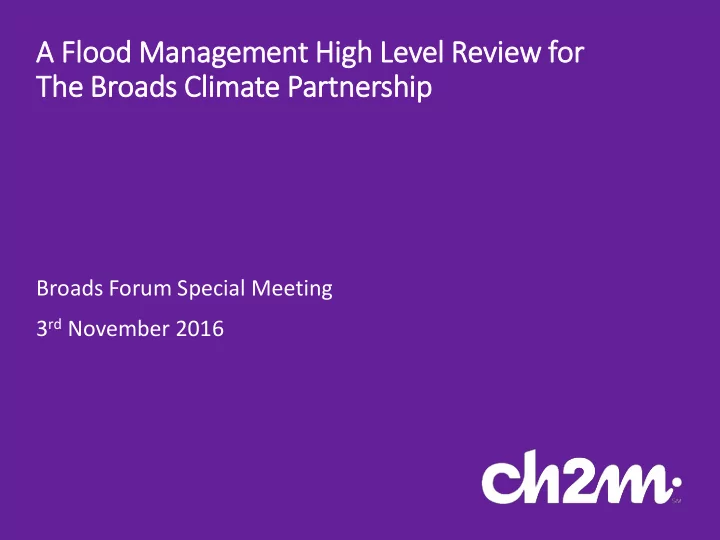

A Flo lood Management Hig igh Level Revie iew for The Broads Clim limate Partnership Broads Forum Special Meeting 3 rd November 2016
Background 2
Current position • Flood risk management across this area has up until now been covered by three separate strategies. – Eccles to Winterton, Great Yarmouth, and Broadland • But these have set boundaries that do not necessarily facilitate the most holistic long term approach to the larger area – There are several interrelationships that mean certain decisions in one area can affect outcomes and choices in another. • There remains an ongoing requirement to maintain defences to manage the risk of inundation over the decades to come. 3
Scope of the review • At a high level, collate and summarise the present flood defence strategies, • Additionally, summarise the state of knowledge regarding requirements for a tidal barrier and the likely economic situation regarding provision of flood defences • Identify the interrelationships and assess the appropriateness or otherwise of proceeding with individual or combined strategy(ies) • Initiate thinking for developing longer term and wider flood risk management strategy • This review is not that strategy – it is the first step and provides a starting point for promoting discussion on ‘what next?’ 4
Overview of strategies and assessments 5
6
Great Yarmouth flood defences Flood Compartments E F Breydon Br GREAT Haven Br YARMOUTH G C H B J A Key Limit of closure formed by road embankment 7 Closure bank required to prevent flooding from Broadland Flood compartment Extent of flood risk area A
BROADLANDS Progress (end of 2015) 235 km upgraded over the first 13 years – around 20 km of flood banks per year . Now in maintenance phase. 8
Interrelationships • Coastal processes • Flood risk • Water management • Natural environment / biodiversity • Social / human environment • Legislation, political relationships and responsibilities 9
Existing Strategies • The interrelationships between the areas in terms of possible consequences / opportunities demonstrate that works should no longer be considered independently • A single strategy would be more appropriate to cover this whole area, so that decisions take account of wider effects and benefits, and potentially incompatible approaches are not developed. 10
Barrier • A tidal barrier at Great Yarmouth is one option that has been suggested for providing part of a future flood defence system. Vertical Lift Gate Hull Barrier, UK Rising Sector Gate Ipswich Barrier, UK Vertically Hinged Horizontal Sector Gate - New Orleans 11
Barrier – Questions? • Different perspectives on what the expectations for a barrier are: – Is it to manage flood risk from tidal surges, or saline intrusion , or both? • Acceptable frequency of barrier operation (closures necessary for managing flood risk and/or saline intrusion)? – Is the increase in these with climate change going to be acceptable? • What will be the navigation requirements and constraints which a barrier scheme would need to accommodate? • How can/will a barrier affect flood risk issues in Great Yarmouth too? • How are future (potentially increasing) barrier operation and maintenance costs going to be funded? 12
Headline Economics – ‘Benefits’ • The total value of land and properties within the area is approximately £1,760 Million • The present value economic benefits (PVb) of protecting land and properties from flood risk is estimated to be between £900 Million and £1,200 Million 13
Headline Economics – ‘Costs’ • The estimated cost of continuing to protect these assets is likely to be £400 Million and £500 Million over the next 50 years, with a present value (PVc) of £200 Million to £300 Million LOWER BOUND COST UPPER BOUND COST YEARS ESTIMATES ESTIMATE (£million) (£million) CASH PVc CASH PVc 1 to 10 95 - 135 76 - 108 210 168 10 to 20 75 - 80 45 - 48 110 66 20 to 30 65 - 120 26 - 48 75 30 30 to 40 50 - 70 15 - 21 60 18 40 to 50 60 - 65 12 - 13 55 11 Total ~ 400 ~ 200 ~ 500 ~ 300 14
Headline Economics - Funding • Under treasury current funding eligibility rules, central government grant aid (FDGiA) will not meet all of that cost. • It is estimated that between £120 Million and £200 Million (PV) will need to be found through partnership contributions. • That could equate to anything up to £250 Million to £350 Million in ‘real cash’ terms. 15
Conclusions of the Review 16
Summary • An update of all three current strategies is going to be required very soon – development of a single overarching strategy is recommended. • A new strategy might challenge previous assumptions or present new opportunities, so warrants a fresh appraisal of options – Sourcing of funding is going to be a fundamental element for determining future flood risk management strategy across this area – There are a significant number of outstanding questions and potential permutations of options, with numerous possible outcomes. • Definitive direction is going to be required – some decisions need to be made ahead of strategy development • Current activities to maintain defences continues for the time being, but the need to consider ‘what next’ is now here 17
A Flo lood Management Hig igh Level Revie iew for The Broads Clim limate Partnership Broads Forum Special Meeting 3 rd November 2016
Recommend
More recommend